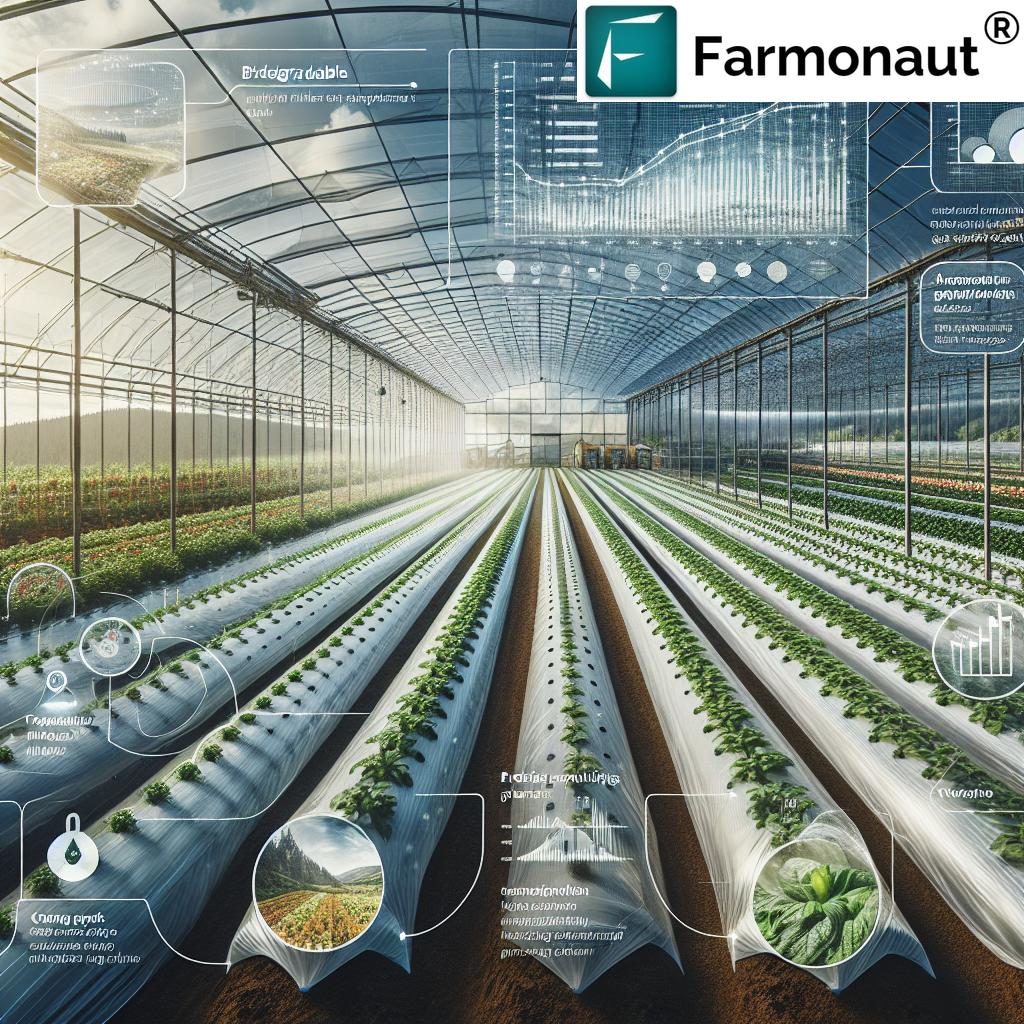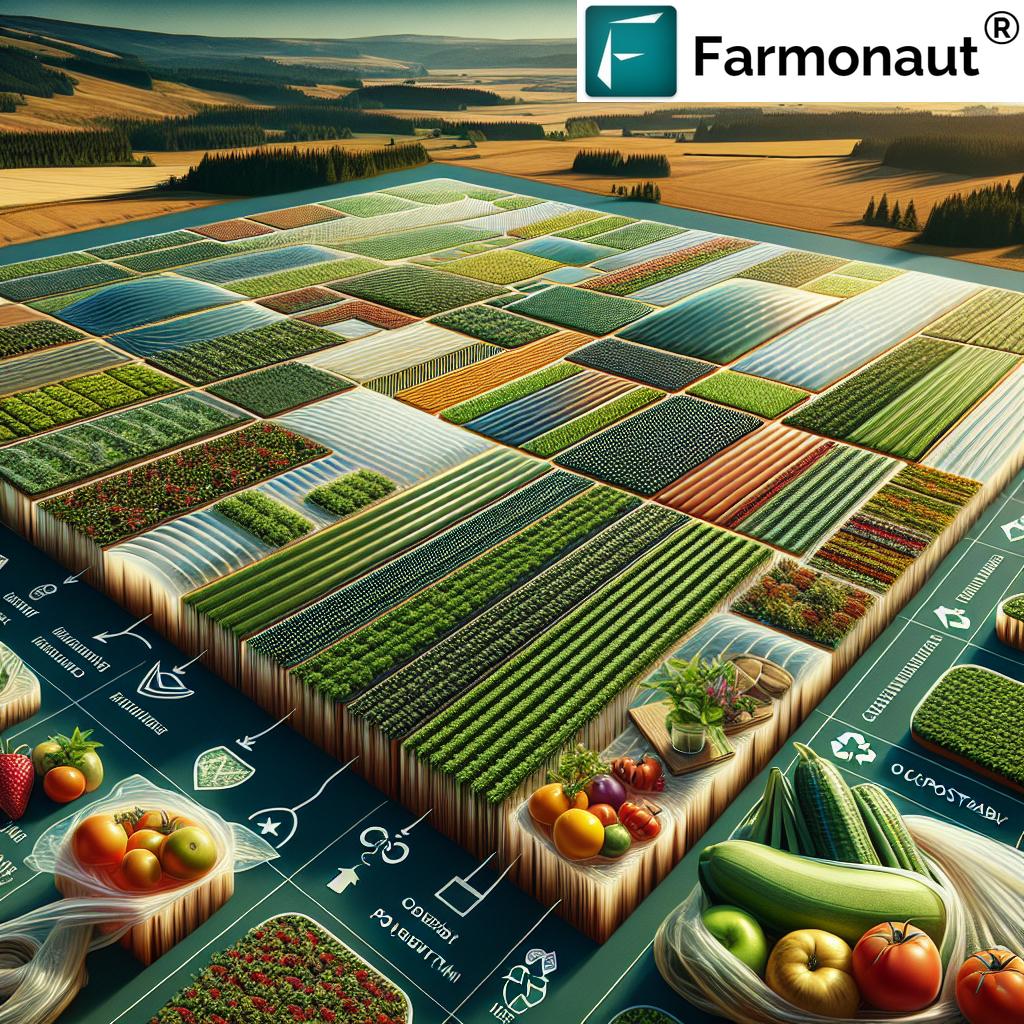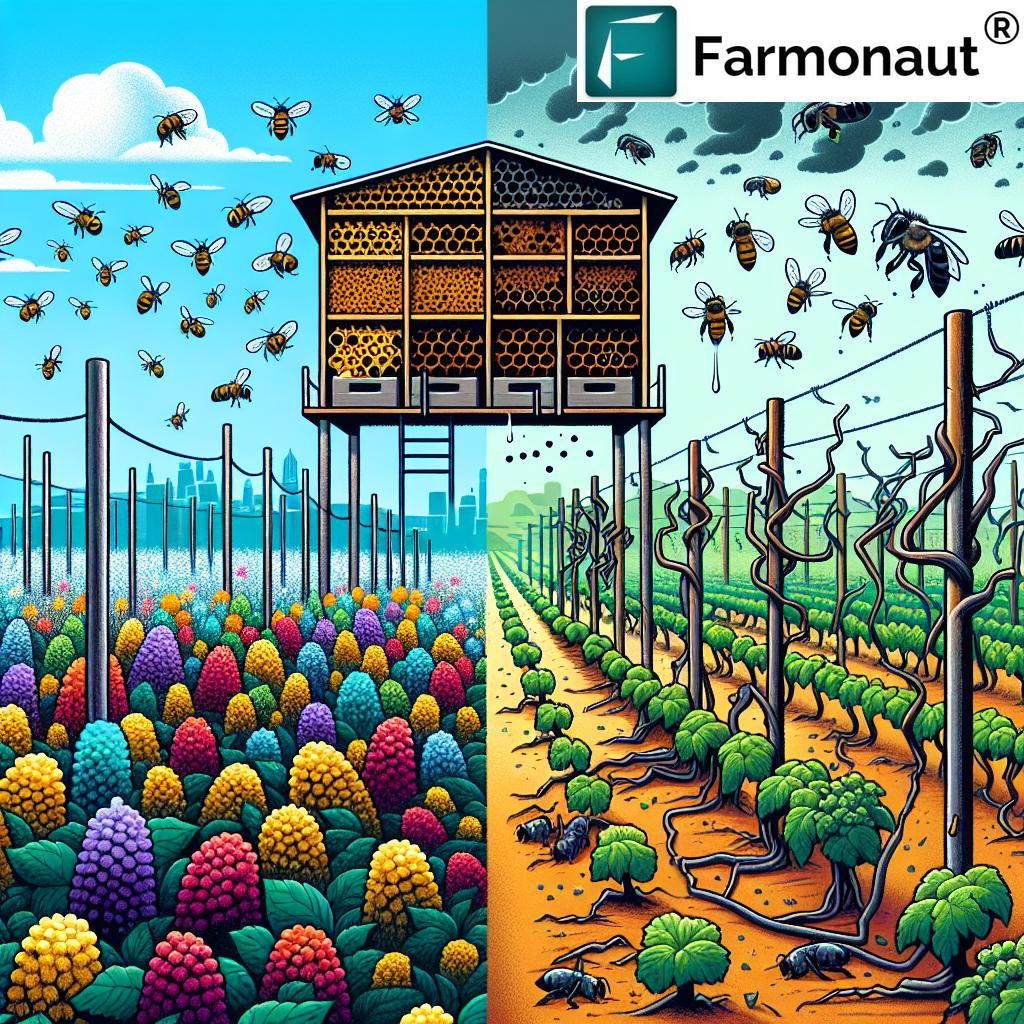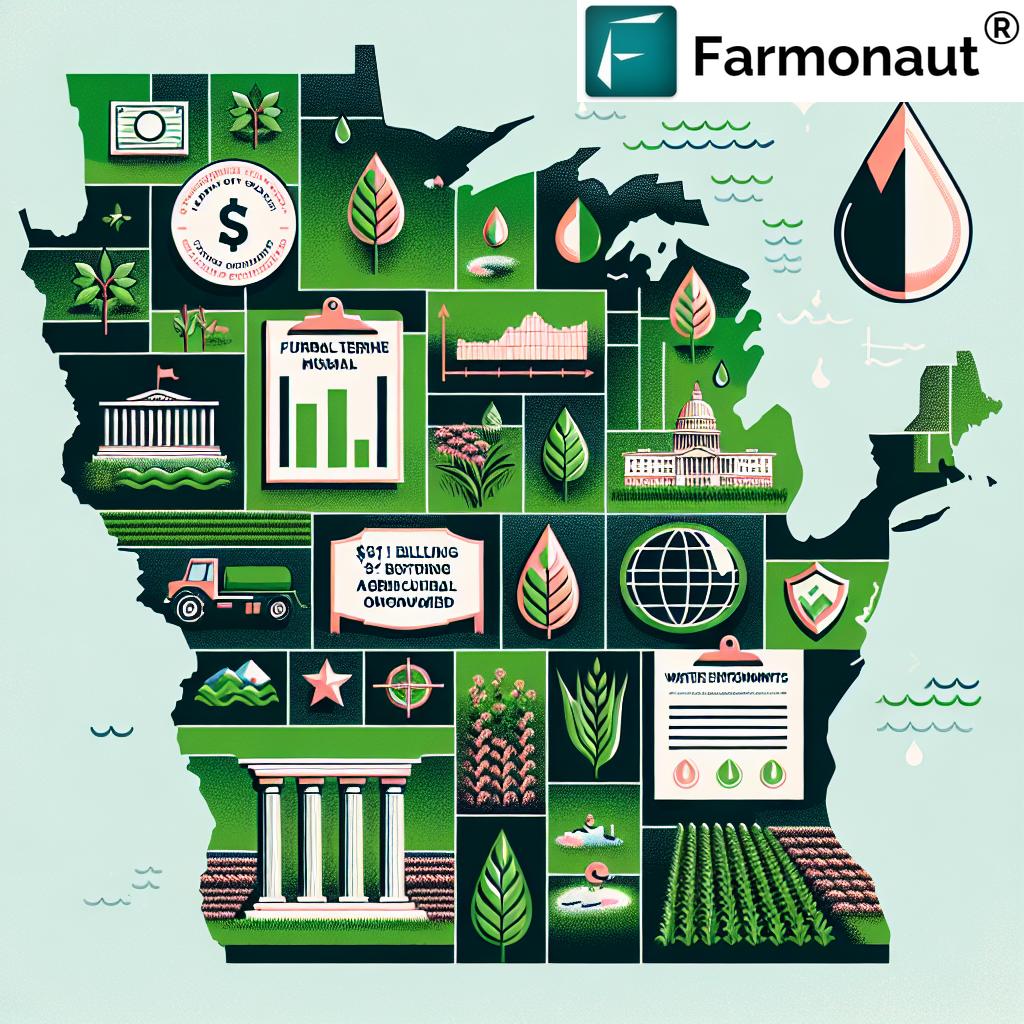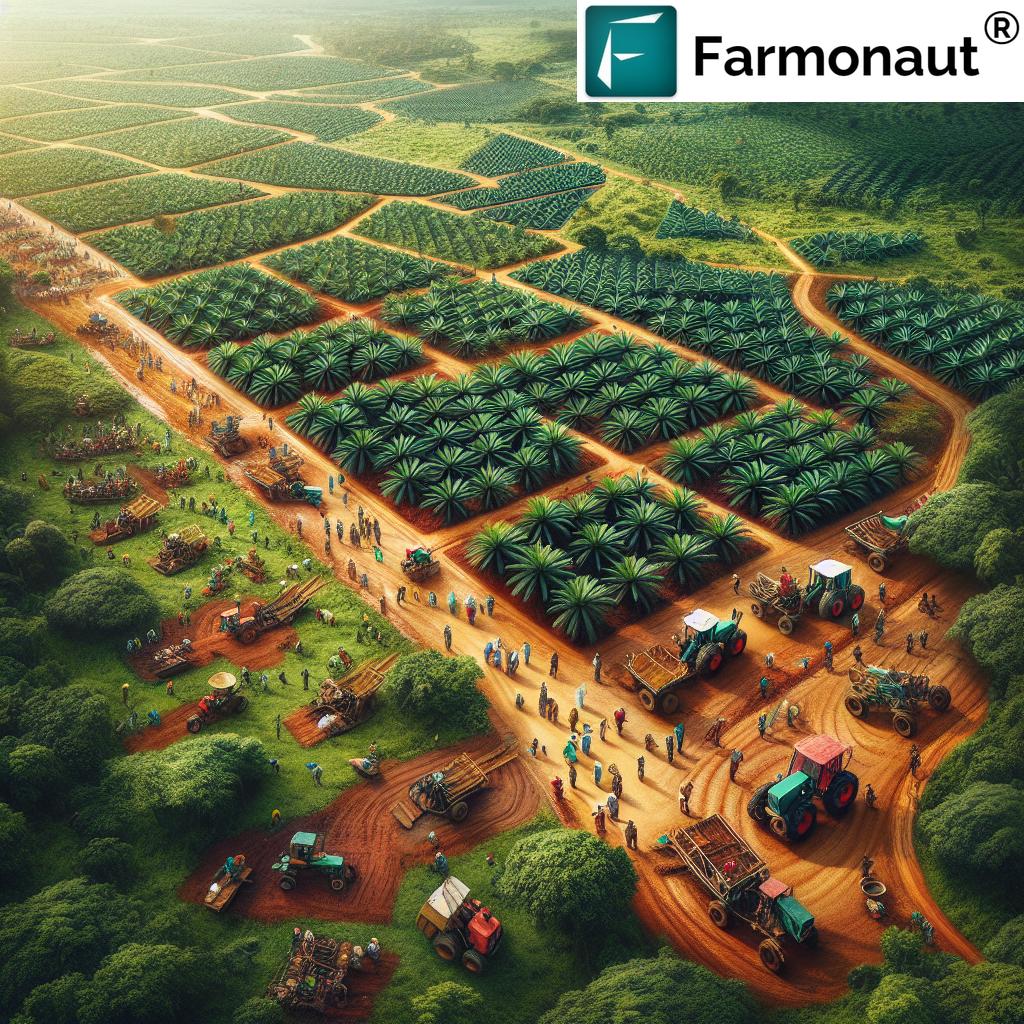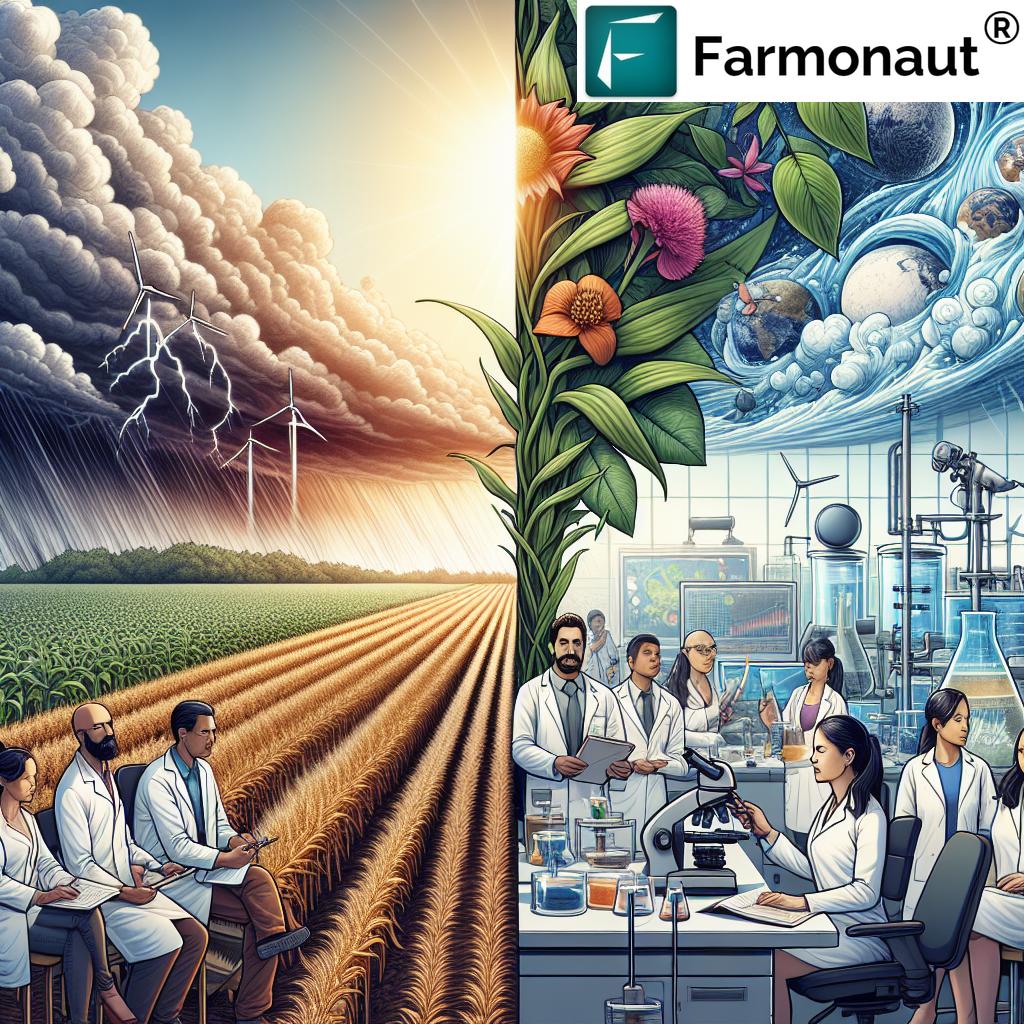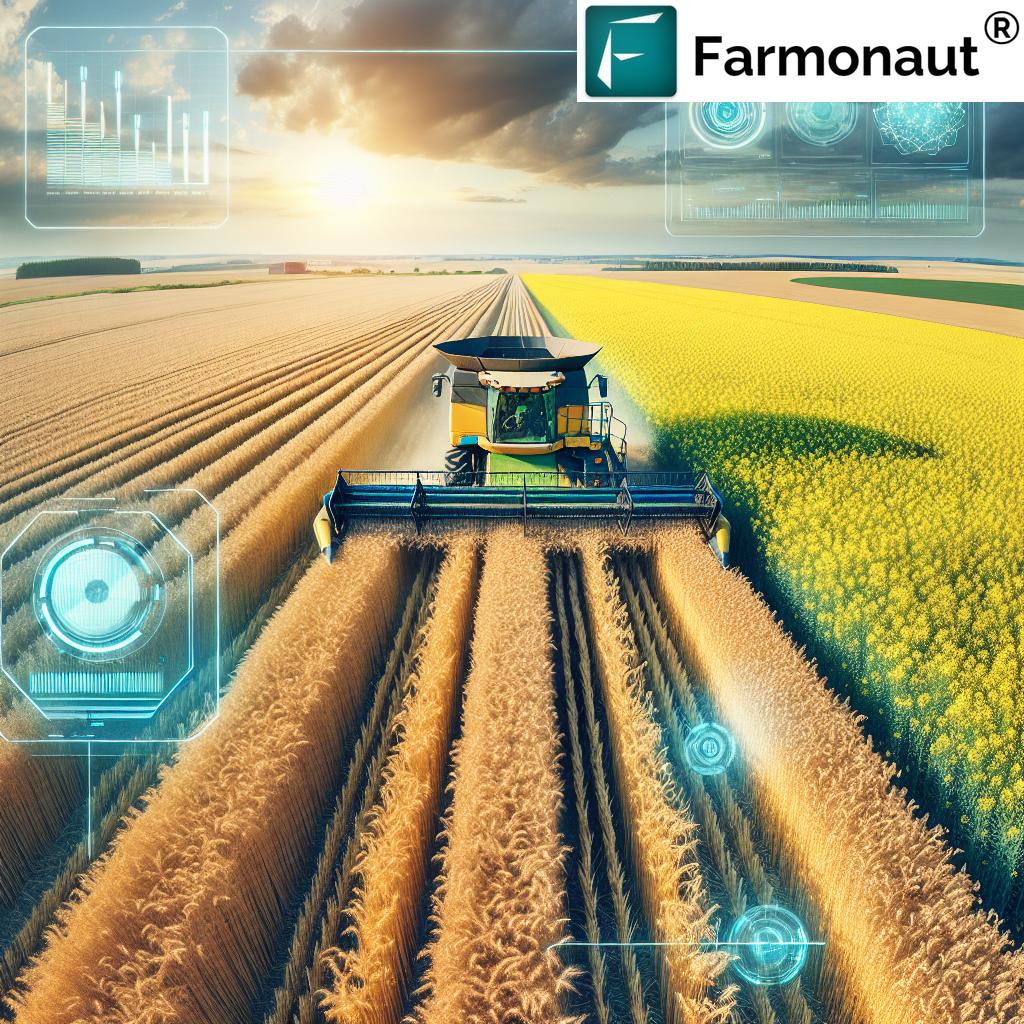Agricultural Films Market 2025: Key Global Trends & Growth Insights
“The global agricultural films market is projected to reach $12.2 billion by 2025, driven by rising demand for food production.”
Agricultural Films Market growth is accelerating globally in the wake of increased food demand, rapid technological advancements, and the urgent call for sustainable farming solutions. As we approach 2025, the industry is set to reach USD 12.2 billion, with projections soaring to USD 16.4 billion by 2034. This seismic shift is powered by emerging market trends, pioneering innovations, and the global adoption of smarter, precision-driven agriculture methods.
In this extensive agricultural film market analysis 2025, we, at Farmonaut, explore the evolving landscape of the global agricultural films market. Drawing on the latest data, reports, and key insights, we’ll guide you through the market’s trajectory, influential factors, sustainable materials, application-specific products, competitive players, and new growth opportunities for 2025 and beyond.
Market Overview & Growth Trajectory
Let’s begin our comprehensive agricultural film market analysis 2025 by examining the big picture:
- Market Size: The global agricultural films market is estimated at USD 11.4 billion in 2024 and projected to rise to USD 16.4 billion by 2034 (source: The Research Insights report).
- CAGR: Expected compound annual growth rate (CAGR) is 3.8% from 2024 to 2034, with certain segments like biodegradable mulch films exceeding a 7% CAGR.
- Growth Drivers: Increasing adoption of precision agriculture, recent advances in farming materials (especially polyethylene and biodegradable options), and a global consumer shift towards sustainable agricultural materials.
We see the agricultural films market intersecting technological innovation and urgent food security challenges. This transition is marked by robust investments in high-performance silage, greenhouse films, and new eco-friendly film solutions.
Key Factors Driving the Agricultural Films Market
1. Rising Need for Food Production and Protected Farming
As global population increases and arable land remains limited, there is intensified demand for methods that maximize productivity and crop yield. Agricultural films—including mulch, greenhouse, silage, and tunnel films—help us maintain favorable soil and atmospheric conditions, supporting fruit, vegetable, horticultural, and floricultural crop growth.
- Mulch Films retain soil moisture, control temperature, prevent weed growth, and ensure improved nutrient uptake in crops.
- Greenhouse Films enable all-year farming, stabilize microclimates, and reduce temperature fluctuations in controlled environments.
- Silage Films protect fodder crops from oxidation and spoilage, thereby reducing wastage during storage.
- Tunnel Films are used for low and high tunnel farming, helping maintain optimal humidity and temperature for sensitive crops.
2. Precision Agriculture Market Growth
With digitalization in agriculture, precision, smart, and climate-adaptive farming methods have become mainstream. Technologies such as carbon footprinting tools and real-time crop monitoring platforms (like Farmonaut’s advanced solutions) ensure efficient use of agricultural films and sustainable practices at scale.
AI-driven data—combined with satellite technology—enables smarter application and recycling of film materials, reducing waste and environmental impact.
3. Regulatory Push and Environmental Awareness
Environmental concerns over plastic waste have prompted governmental regulations—especially in Europe and North America—mandating the use of biodegradable and compostable agricultural films. Farmer and manufacturer awareness is higher than ever, leading to the rapid adoption of innovative materials and advanced recycling systems.
Trivia: “Biodegradable films are expected to grow at a CAGR of over 7% by 2025, reflecting a shift toward sustainable farming.”
4. Technological Advancements & Performance Improvements
We are seeing the rise of UV-resistant, thermic, photodegradable, and color-specific films designed to meet the specialized needs of various crops, climates, and regional requirements. These advanced materials offer superior durability, better light diffusion, increased temperature control, and improved crop protection throughout the farming season.
Try our satellite-powered app to monitor crop health, optimize farming resources, and stay ahead of market trends!
Global Shifts Towards Sustainable Agricultural Film Solutions
Biodegradable Mulch Films: Market-Driven Sustainability
The agricultural films market is witnessing a dramatic transition toward sustainable agricultural materials. Biodegradable mulch films, designed to break down into harmless residues after their functional period, are now becoming mainstream.
- Eco-Efficiency: Biodegradable films eliminate the difficult (and expensive) process of removing plastic waste after harvest, thus minimizing operational expenses and boosting soil health.
- Policy Support: Many European regions are incentivizing—and even mandating—the adoption of compostable agricultural films for fruit, vegetable, and ornamental crop applications.
- Performance: When produced with polymers, such as starch blends and advanced bioplastics, these films maintain comparable performance to conventional polyethylene-based solutions, ensuring they can replace conventional plastics without compromising crop efficiency.
The result is an agricultural films market that’s more future-proof, with manufacturers moving toward unique, eco-friendly offerings with global applicability.
Looking for other sustainability-driven solutions in agriculture? Explore Farmonaut’s Carbon Footprinting service—a powerful tool helping us track, manage, and reduce the carbon footprint of farming operations worldwide.
Greenhouse Farming Solutions: Innovations in Films
A substantial part of market growth comes from the surge in greenhouse and tunnel film adoption. Greenhouse films with enhanced UV stability, diffused light transmission, and anti-condensation properties are now central to advanced horticulture and floriculture films applications worldwide.
- Geographical Hotspots: Netherlands (Europe), India (Asia-Pacific), Kenya (Africa), and USA (North America) are market leaders leveraging greenhouse films for high-value crops and export-facing floral industries.
- Season Extension & Efficiency: Greenhouse films allow us to cultivate sensitive plants during unfavorable environmental periods, reducing pesticide requirement and maximizing harvest cycles annually.
- Reduced Pesticide Use: Stable microenvironments formed by these films reduce pest pressure and disease occurrence.
Advanced plastic film solutions for farming use special materials—like LDPE, LLDPE, and EVA—which offer superior light diffusion for improved crop growth and minimized risks due to temperature fluctuations.
Table: Global Agricultural Films Market – Regional Growth & Key Trends (2023–2025)
| Region | Estimated Market Size 2025 (USD Billion) | Annual Growth Rate (CAGR %) | Major Application Segment | Key Market Drivers | Notable Market Trends |
|---|---|---|---|---|---|
| Asia-Pacific | 5.2 | 4.1% | Mulch & Greenhouse Films | Governmental support, Population growth, Precision farming adoption | Expanded plasticulture, Advanced LDPE/LLDPE films, Smart farming integration |
| Europe | 3.4 | 3.5% | Greenhouse & Biodegradable Films | Environmental regulations, Floriculture export, Sustainability mandates | Biodegradable film rise, Policy-driven sustainability, Light/UV modification |
| North America | 1.9 | 3.2% | Silage & Mulch Films | Large-scale farming, Technological innovation, Livestock feed demand | Recycling programs, Smart farming, Performance improvement |
| Latin America | 1.0 | 3.9% | Greenhouse & Silage Films | Crop exports, Expanding protected horticulture, New farming methods | Transition to eco-films, High-yield farming, Climate resilience focus |
| Middle East & Africa | 0.7 | 4.2% | Greenhouse Films | Water scarcity, Protected agriculture, Horticultural expansion | Drip irrigation synergy, Durable films, Export-driven production |
Applications, Materials, and Products in Agricultural Films
Leading Material Segments Powering the Market
The choice of film material impacts both sustainability and farming efficiency.
Key segments include:
- Low-Density Polyethylene (LDPE): Dominates the market share due to flexibility, good light transmission, and reliable durability for mulch and greenhouse films.
- Linear Low-Density Polyethylene (LLDPE): Offers higher puncture resistance and stretch, excellent for covering varied crops in changing climatic conditions.
- High-Density Polyethylene (HDPE): Used where advanced toughness and chemical resistance are mandatory.
- Ethyl Vinyl Acetate (EVA): Used in premium films, enhancing light properties and temperature insulation.
- Biodegradable Polymers: Made from plant-based feedstocks, decomposing in soil for lower environmental impact.
- Reclaimed Materials: Recycled plastics enter the supply chain, supported by emerging recycling strategies and governmental incentives.
Mulch and Silage Film Applications—Meeting Modern Farming Demands
-
Mulch Film Applications:
- Vegetable Farming: Reduces weed presence, preserves soil moisture, and increases yields.
- Fruit Orchards: Promotes more consistent fruit growth and reduces pathogen spread by limiting soil-crop contact.
- Horticulture: Specialized color films offer improved light absorption and pest management.
- Water-Scarce Regions: Advanced films conserve water and help stabilize microclimates.
-
Silage Film Applications:
- Forage Preservation: Superior barrier properties keep oxygen and moisture out, ensuring high-quality silage for animal feed.
- Food Security: Reducing wastage at the fodder storage level directly impacts farm profitability.
In regions like India (Asia-Pacific), the extensive deployment of durable mulch and silage films has changed agricultural practices for high-density plantations.
For advanced large-scale farm operations, learn about Farmonaut’s Large-Scale Farm Management solution.
Greenhouse, Tunnel, and Specialty Films: Expanding the Range of Applications
- Greenhouse Films: Allow growers to manipulate light, temperature, and humidity for specialty and export-driven crops like floriculture, berries, and high-value vegetables. UV, IR, and anti-drip features support optimal conditions year-round.
- Tunnel Films: Applied over metal or plastic frames, they offer weather protection for ultra-early or late-season crops—crucial for maximizing off-season market prices.
- Fumigation Films: Provide chemical barriers during soil treatment, helping minimize disease and pest issues in regions with intensive monoculture.
- UV-Blocking Films: Shield sensitive plants from excessive radiation and reduce microbial growth—a critical factor in vegetable, fruit, and flower markets.
Segmentation by Application and Geography
- Horticulture: The largest application segment, representing over one-third of the market share in 2024. Used extensively for vegetables, fruits, and nursery crop production.
- Floriculture: Specialized greenhouse films are vital for international flower production hubs like the Netherlands and Colombia.
- Fodder & Silage Storage: Widespread use of advanced silage wraps ensures livestock feed security in all major farming regions.
Regional Market Analysis & Growth Opportunities
Understanding geographical market dynamics is central to informed strategic decisions for stakeholders.
Asia-Pacific: The Powerhouse of Growth
- Market Share: Accounts for over 42% of the global market, led by China and India.
- Growth Drivers: Expanding agricultural land, population-driven food demand, government subsidies for protected cultivation, and a rapid shift to smart agriculture platforms.
- Opportunities: Precision agriculture, fleet management, and innovative film solutions—see Farmonaut’s Fleet Management product for optimizing farm vehicle use and reducing operational expenses.
Europe: Sustainability and Innovation Leaders
- Major Players: Netherlands, Spain, Italy, France.
- Key Characteristics: World-class horticulture and floriculture; aggressive adoption of biodegradable films; regulatory support for compostable and recyclable agricultural products; innovation in color/light-diffusing films.
- Trend: The continent leads in the integration of precision agriculture and compliance-driven sustainability.
North America: Precision and Productivity
- Strongholds: USA, Canada
- Market Segments: High-value mulch and silage film sectors, increasing implementation of recycling and waste reduction protocols.
- Technological Focus: Emphasis on smart, data-driven film use in farming—Farmonaut’s Traceability solution helps North American farmers and food companies ensure reliable product origins and supply chain transparency.
Latin America: Emerging Protected Culture Regions
- Growth: Expansion in protected horticulture, fruit production, and export-focused farming. Widespread deployment of greenhouse and tunnel films to support high-yield crop cycles.
- Opportunities: Upgrading to eco-friendly and performance-oriented films for water-constrained environments.
Middle East & Africa: Adapting to Climate and Water Scarcity
- Adoption: Fastest-growing regions for greenhouse film solutions, driven by climate adaptation needs and the popularity of protected horticulture.
- Trends: Focus on hydroponics, high-yield farming, and performance films that maximize water-use efficiency.
Discover how Farmonaut’s API and Developer Documentation provide direct integration for precision farming, weather monitoring, and agricultural film application analytics.
Key Players & Competitive Landscape in the Agricultural Films Market
The global agricultural films market is marked by robust competition and strategies focused on new product launches, joint ventures, and international expansion.
Notable companies include:
- Berry Global Inc
- RKW Group
- Coveris
- Ab Rani Plast Oy
- Industrial Development Company Sal
- Armando Alvarez Group
- Kuraray Co., Ltd
- Plastika Kritis
- Trioworld Industrier AB
- Groupe Barbier
- Polifilm
- Sigma Plastics Group
- Ginegar Plastics Inc
- Futamura Chemical
- Sanin S.R.L
These key players continue to drive innovation in agricultural films performance, sustainability, and regional market reach.
Technological Innovations and Recent Developments (2024–2025)
- Berry Global Inc: Launched Silotite Film&Film (F&F) balewrapping in April 2025—a solution for improved silage protection, fermentation efficiency, and easier recycling.
- RKW Group: Released Hytilux® greenhouse films in March 2025, which optimize light/temperature balance, reduce heating expenses, and protect against temperature fluctuations. Introduced new greenhouse film/net solutions with enhanced durability in January 2024.
Ongoing research and development focus on:
- UV-blocking, photodegradable, and infrared-reflective films for advanced climate and light control.
- Integration of AI-powered decision support tools for agricultural film application management.
- Recyclability and upcycling innovations, especially for markets with restricted waste infrastructure.
Farmonaut: Advancing Precision Agriculture for a Sustainable Future
At Farmonaut, our mission is to enable precision and sustainable agriculture affordable and accessible to the widest possible audience. Leveraging a unique blend of satellite technology, AI-driven advisory, blockchain, and fleet/resource management tools, we empower farmers, agribusinesses, and institutions globally to maximize productivity and sustainability in modern farming.
-
Satellite Crop Health Monitoring:
Our platform delivers real-time, multispectral data on crop health, NDVI, soil moisture, and resource use, crucial for optimizing mulch and greenhouse film applications, reducing waste, and improving crop quality. -
AI-Based Jeevn Advisory:
Powered by AI, Jeevn gives personalized recommendations, weather insights, and operational advice—helping ensure farms use the right film solutions, at the right time, for maximum benefit and cost savings. -
Blockchain Traceability:
Build trust with consumers and supply chain partners using our blockchain product traceability tools. This is critical for meeting modern consumer preferences and regulatory demands for transparent, safe, and high-quality food. -
Fleet & Resource Management Tools:
Save on operation costs by optimizing vehicle use, reducing downtime, and improving logistics—essential for large farm and contract operations using wide-ranging plastic film solutions for farming. -
Carbon Footprinting:
Quantify and reduce the environmental impact of your agricultural activities, track emissions, and align with sustainability certifications for increasingly eco-conscious global markets.
Our solutions are available on Android, iOS, web apps, and robust API suites—customized to the unique needs of farmers, cooperatives, corporations, governments, and financial institutions.
Frequently Asked Questions
What is the agricultural films market?
The agricultural films market encompasses all plastic film solutions and advanced materials used in crop production, protection, soil health management, and storage within the global agricultural sector.
Which materials dominate the market, and why?
Low-density polyethylene (LDPE), linear low-density polyethylene (LLDPE), and increasingly biodegradable polymers dominate, owing to their durability, flexibility, and contribution to sustainable and climate-resilient farming.
How do biodegradable mulch films address environmental issues?
Biodegradable mulch films break down after use, eliminating post-harvest waste collection, improving soil health, and minimizing environmental footprint—key for regulatory compliance and long-term sustainability.
Which regions are leading growth and adoption?
Asia-Pacific leads global growth (especially China and India), Europe is a center for sustainability innovation and adoption, while North America drives technological and productivity gains.
How does Farmonaut support precision agriculture and sustainable farming?
Farmonaut empowers farmers and agri-businesses with real-time crop monitoring, AI-based analytics, blockchain traceability, and resource optimization—all via affordable, accessible apps and APIs.
Where can I find tailored agricultural satellite and weather data?
Explore Farmonaut’s API and developer resources for customized, on-demand data for agriculture and related industries.
How can I manage large-scale farms or support crop loans with technology?
Discover Farmonaut’s Crop Loan and Insurance verification solutions and our Agro Admin App for large farms.
Conclusion: Unlocking Opportunities in the Agricultural Films Market
As we track the remarkable evolution of the global agricultural films market leading up to 2025 and beyond, several clear messages emerge:
- Market opportunities are vast: With a projected value of USD 16.4 billion by 2034, growth is fueled by both population-driven food demand and the ever-rising priority on sustainability and efficiency.
- Sustainability is indispensable: The adoption of biodegradable mulch films and compostable solutions is not just a trend but a necessity, as climate and regulatory landscapes evolve worldwide.
- Technology integration is the new standard: From advanced polymers and precision film formulations to satellite-based farm management platforms like Farmonaut, the fusion of tech with agriculture is enabling better decisions, resource savings, and greener operations for each stakeholder.
- Regional opportunities abound: Whether you farm in Asia, Europe, North America, Latin America, or Africa, there is strong potential for market expansion, improved crop quality, and participation in the global sustainable farming movement.
By staying abreast of industry trends, research developments, and innovative film applications, agri-businesses, farmers, manufacturers, and investors can claim their share in the future of farming.
Ready to digitize, optimize, and sustain your farm’s future?
Join Farmonaut’s revolution in data-driven, precision agriculture—your gateway to the next generation of profitable and sustainable farming.
References:
– The Research Insights Agricultural Films Market Report 2025–2034
– Farmonaut Official Website


